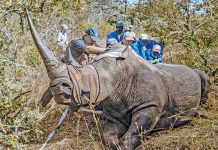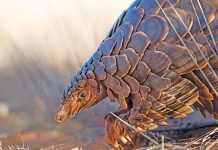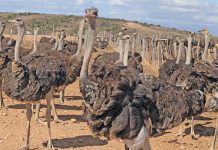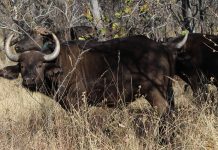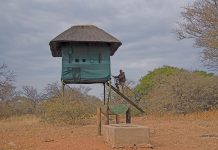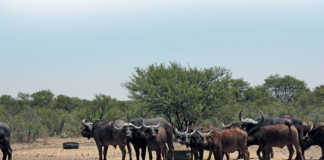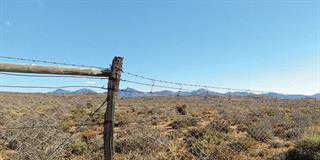Anticipation ahead of the Stud Game Breeders auction on 4 September this year was high. But it reached fever pitch when stud game buyers received ultrasound scans of sable antelope, roan antelope and buffalo. Vets had already confirmed the animals were pregnant, but the scans meant buyers could see the embryo or foetus for themselves. One of the animals scanned was a buffalo cow (Lot 152) from Mpumalanga’s Kwanare Game Farm, shown to be in the early stages of pregnancy to a renowned stud male.
The buffalo’s gestation period is 11 months and combined with her impressive calving dates (22/03/10; 01/03/09; 26/02/08; 07/01/07), there’s every chance Lot 152 will produce another calf by March 2011. She sold for the highest price ever paid for a female buffalo – R1,75 million. Several sable antelope were also scanned, with auction prices for females ranging from R214 000 per cow to the highest price to date of R850 000.
A routine procedure
The scans undoubtedly added value to the process and possibly meant that buyers were a little more willing to push up the price. Certainly, wildlife scanning is on the increase as the stud game industry grows and the millions flow.Bela-Bela vet Dr Hendrik Hansen has been scanning livestock and wildlife for the past 13 years.
“Scans excite game breeders and buyers in exactly the same way they excite livestock breeders,” he says. “These are animals used for breeding, and sellers and buyers want to know whether the animal they have their eye on is fertile with a good intercalving period. It’s all about production and improvement.”
Still, what does it feel like scanning a R1,75 million buffalo cow for her million-dollar calf? “I don’t think about the price of the animals – if I did it could be tricky,” Dr Hansen smiles. “For a vet it’s a routine procedure. You’re working on an animal and you take every bit of care, irrespective of whether it’s a stud buffalo or a sheep or a cow.“The main difference is that you must immobilise or anaesthetise wild animals when you scan them.”
A30-80 (thiofentanyl) is used, with the dose varying according to the animal, adds Dr Hansen. “The animal is out for five to 10 minutes. At Kwanare (a member of Stud Game Breeders) we immobilised five buffalo at a time in the boma. All five were scanned in about 15 minutes. It takes a bit longer if the vet needs to draw blood to determine if, for example, the buffalo is disease-free.
Accurate and effective
How does it work? “I do an internal scan with a rectal probe – which can be used for most animals,” explains Dr Hansen. “The exceptions are animals such as rhino. When we scan rhino we need a special tool to get in deep enough to reach the uterus.“Pregnancy can be picked up from 28 days – the same as cattle. The internal probe is an excellent tool. You can determine if an animal is pregnant, at what stage of pregnancy it is, and you can also pick up the heartbeat to confirm that the foetus is alive. What’s more, in the case of buffalo, you can determine the sex of the foetus if you do the scan from 50 to 100 days of the pregnancy.”
However, after three months you can no longer determine the gender, because the foetus changes position and becomes too large for a vet to reach down to the elongated uterus and find the right position. “At three months a buffalo uterus is the size of a soccer ball. After that it elongates,” adds Dr Hansen. Vets also use the same hands-on techniques to determine pregnancy in cattle and wildlife, including checking the size of the cotyledons (the placenta connecting to the uterus) and the thickness of one of the placental veins.
But most agree that the rectal probe ultrasound system is accurate and effective, and that it’ll soon be used extensively in the stud game industry. Dr Hansen also believes that interesting progress in embryo transfer in wildlife will be made over the next few years, which will further raise the stakes in stud game breeding.
Embryo transfer in wildlife
Dr Morné de la Rey, who’s based in Brits, is one of the leaders in this field. “Embryo transfer in wildlife is getting really close,” he says. “My father, Dr Ronnie de la Rey, did some embryo flushing in the 1980s, where he implanted buffalo embryo into cattle. “The cattle aborted after about 40 days due to immunological differences, but it helped develop the science, which has made huge advances in cattle breeds such as Boran.
At that stage the idea was to multiply the genetics, and we used cattle as recipients.“Important work is now going to be done on buffalo using embryo flushing and DNA-typing of the calf. We’ve already learnt you can do embryo flushing without spreading diseases, which means you can harvest embryos from buffalo in Kruger National Park or Tanzania and transfer them to clean buffalo, thereby achieving a much greater distribution of genetics.”
The embryos are washed in a liquid containing enzymes that kill all viruses, including bovine TB, foot-and-mouth disease and brucellosis. Semen can be washed in the same way.“This means that while infected live animals transmit disease, once you wash the embryos and the semen there’s virtually no risk of spreading disease. We test the semen and embryos to confirm they’re disease-free,” explains Dr De la Rey.In addition, genetic banking of DNA material from wildlife is ongoing.“There’s still a lot of work to be done on embryo and semen transfer in wildlife, and funding has been limited, but the growth of the stud game breeding industry certainly opens up more avenues for research,” adds Dr De la Rey.
The future for strong genetics
The potential application in stud game breeding is obvious, and one of these days high-priced buffalo cows such as Lot 152 might be spreading her ova (eggs). Success in this regard has already been achieved with cattle. “In the same way that semen collection multiplies a bull’s genetics, embryo transfer is seen as the most effective way to increase and preserve a cow’s genetics,” explains Dr De la Rey.
“The cow receives hormone injections to produce more ova and is then artificially inseminated with semen. The fertilised egg cells develop into embryos that are flushed from the cow after seven days and transferred to recipients, one embryo per recipient, thus increasing the cow’s offspring and continuing her strong genetic line.”Substitute “buffalo” for “cattle” and you might just be looking at the future of this flourishing industry.
For more information about embryo transfer visit www.embryoplus.com.

